The trees of Connecticut are as varied as the state itself. From the towering white pines of the northwest corner to the weeping willows of the southeast, there is a tree for every landscape.
Over 100 tree species are native to Connecticut, including oaks, maples, birch, and elm. Many of these trees are iconic symbols of the Nutmeg State, such as the eastern white pine, which is the state tree.
Whether you want to add shade to your yard or attract wildlife, there is a tree for you. Here are some of Connecticut’s top iconic plants and everything you need to know about them.
1. Smooth Aster (Aster laevis)
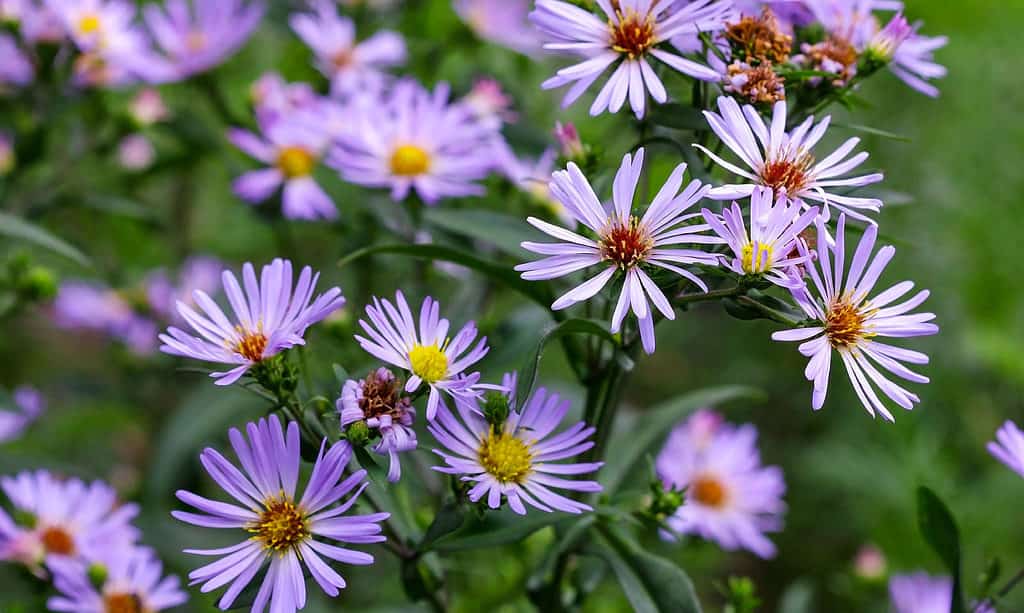
The smooth aster is a perennial flower that blooms from late summer to early fall.
©Tibesty/Shutterstock.com
Asters are one of the most widely grown flowers on the planet and for a good reason. But did you know that there is an aster native to Connecticut?
The smooth aster is a perennial flower that blooms from late summer to early fall. It is a member of the Asteraceae family, including daisies, sunflowers, and chrysanthemums. You can find smooth aster in Connecticut’s woods, fields, and meadows.
The tree prefers well-drained soil and partial shade. Additionally, it is relatively drought-tolerant once established. Its leaves are lance-shaped and green, with a white or pale green underside.
The flowers are on long stems and come in shades of blue, purple, pink, or white. If you are looking for a native plant that will add color to your garden from late summer into fall, consider planting smooth aster.
2. Black Oak (Quercus velutina)
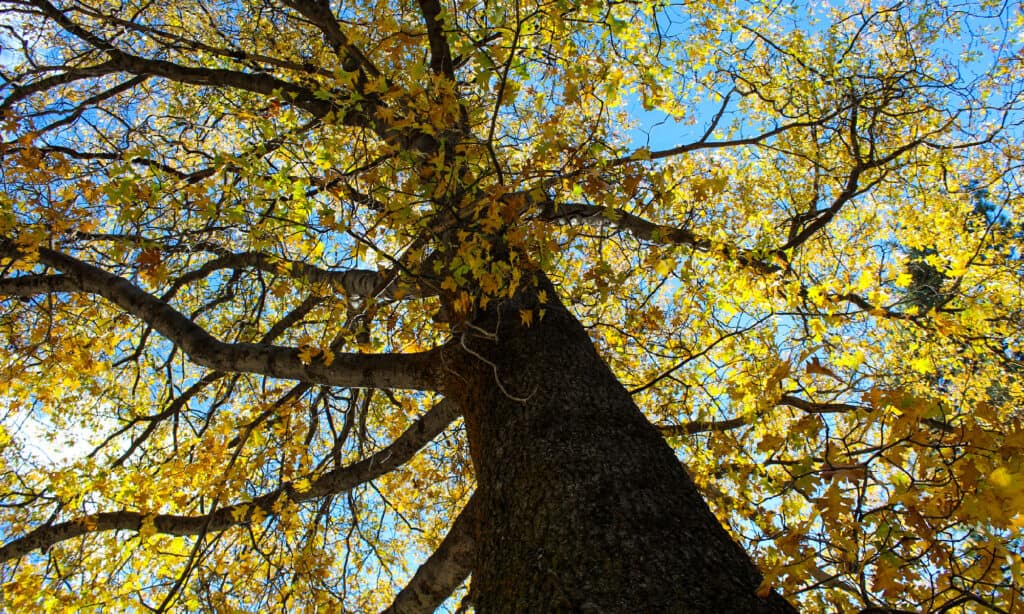
The black oak’s wood is strong, heavy, and hard.
©iStock.com/Jared Quentin
The black oak is a tree native to eastern and central North America, including Connecticut. It is a deciduous tree that typically grows to heights of 60 to 80 feet and has dark brown or black bark.
The leaves of the black oak are dark, green, and glossy and have five to seven lobes. Moreover, the black oak prefers silty, well-drained loamy to clay soils.
In the fall, the leaves turn reddish-brown before they shed. The black oak produces tiny acorns, an important food source for wildlife, including squirrels and birds.
The black oak’s wood is strong, heavy, and hard. It is used to make furniture, mine timbers, railroad ties, boxes, pallets, and flooring, among other uses.
3. Eastern Hemlock (Tsuga canadensis)
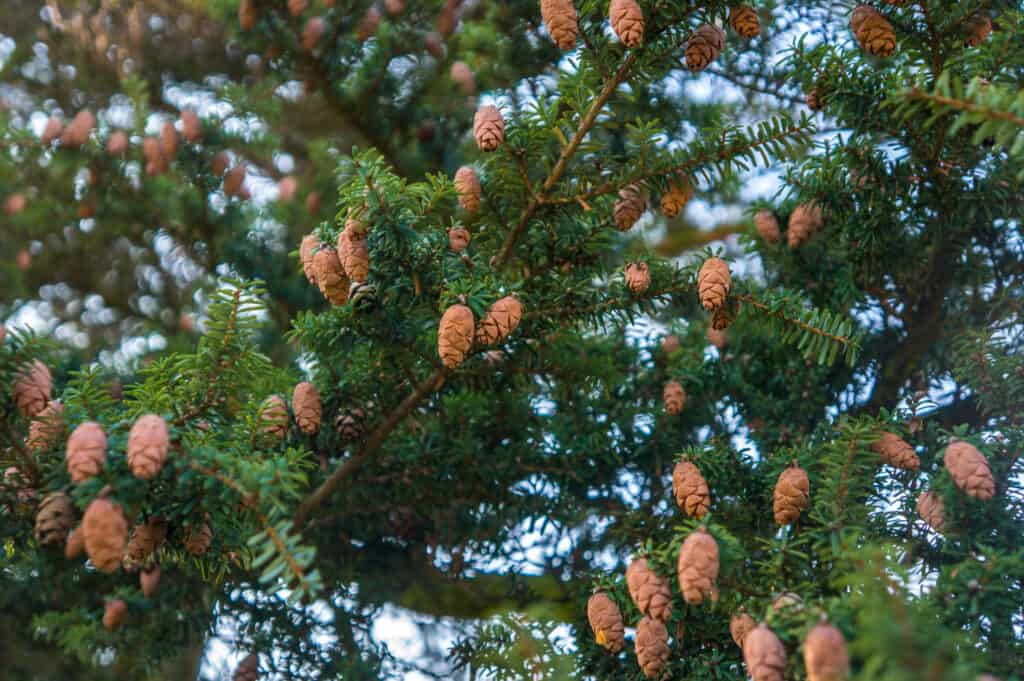
Hemlock trees can endure heavy snowfall and even ice storms.
©iStock.com/Sara Lissaker
The eastern hemlock is a large tree, often reaching 100 feet or more, with a distinctive conical shape and drooping branches. The eastern hemlock is an important species for both humans and animals.
The eastern hemlock has various purposes for humans. The tree’s wood is soft and lightweight, making it ideal for construction and other applications where strength is not a primary concern. In addition, Eastern hemlock tree needles produce essential oils, which have a variety of medicinal and therapeutic applications.
For animals, the eastern hemlock provides essential habitat and food. In addition, the tree’s dense canopy provides shelter for birds and mammals, including the threatened Canada lynx.
The tree’s street needles are also an important food source for several herbivores, including deer and rabbits.
4. The Tree of Heaven (Ailanthus altissima)

The tree of heaven can flourish in partial shade and is tolerant of a broad range of growth conditions.
©APugach/Shutterstock.com
The tree of heaven can grow to a maximum height of around 100 feet. However, most specimens are more diminutive. The tree leaves are pinnately compound and have between 11 and 25 leaflets.
When the tree is young, its bark is light gray and smooth, but it becomes rough and fissured as it matures.
The tree of heaven can flourish in partial shade and is tolerant of a broad range of growth conditions. It also adapts to various soil types, including poor and urban soils. However, it prefers moist, well-drained soil and does not tolerate drought well.
The tree of heaven is a source of timber and traditional medicine in some cultures. It is also helpful as a street tree for landscaping due to its rapid growth and ability to tolerate urban conditions.
Many bird species, including starlings and sparrows, feed on the tree’s seeds, and some butterfly and moth species use the tree as a host plant for their larvae. The tree also provides shelter for various animal species, including squirrels and birds.
However, it is known to be invasive in some areas, so it is essential to carefully consider its potential impacts before planting it.
5. American Sycamore (Platanus occidentalis)
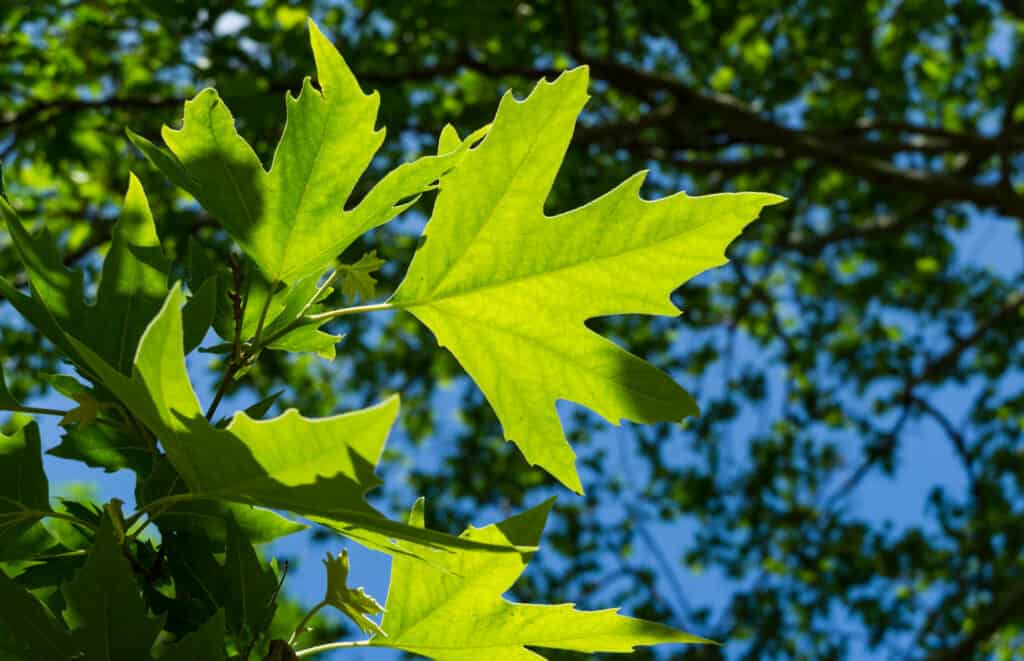
The American sycamore can thrive with six hours of sunlight daily
©iStock.com/Marina Denisenko
The American sycamore is a large deciduous tree native to Connecticut. It can grow to a maximum length of around 100 feet. The leaves of the tree are palmate, with three to five lobes, typically five to eight inches in diameter. When the tree is youthful, its bark is rough, light gray, and smooth but thickens and becomes speckled with age.
The American sycamore can thrive with six hours of sunlight daily. It also adapts to various soil types, including wet and poorly-drained soils. However, it prefers moist, well-drained soil and does not tolerate drought well.
The American sycamore has various uses for humans, including as a source of timber and ornamental purposes. It is also used as a street tree for landscaping due to its large size and attractive bark.
Many bird species, including woodpeckers and finches, feed on this tree’s seeds. Similarly, some species of butterflies and moths use the tree as a host plant for their larvae. The tree also provides shelter for various animal species, including squirrels and birds.
The unique feature of the American sycamore is its mottled bark, made of patches of different colors and textures, giving the tree a distinctive appearance and making it easily recognizable.
6. American Bittersweet (Celastrus scandens)
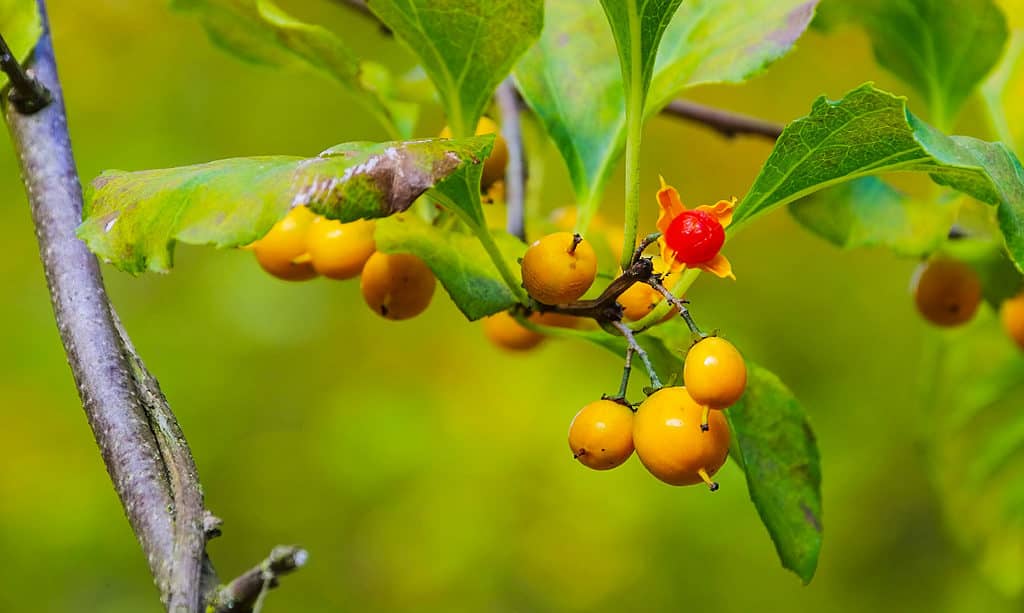
American bittersweet is a climbing plant,.
©LianeM/Shutterstock.com
The American bittersweet, also known as the eastern bittersweet or the climbing bittersweet, is a woody vine native to the United States. It is a deciduous vine, which means that it loses its leaves in the fall.
The leaves of the American bittersweet are oval-shaped and have smooth edges. The bark is smooth and gray when the vine is young but turns brown and scaly as it matures.
The American bittersweet is a climbing plant, and it can grow to be quite tall if it has something to climb on, such as a tree or a fence. It can grow to be up to 30 feet tall.
In terms of growing conditions, once established, the American bittersweet prefers full sun and has a high drought tolerance. It can grow in various soil types, but it prefers well-draining soil.
In terms of its use by animals and humans, the American bittersweet is known for its attractive berries, which are orange and have a sweet taste. The berries provide food for birds and other wild animals. In addition, people use the American bittersweet vines in floral arrangements, and the plant is sometimes grown for its decorative appeal.
The American bittersweet is distinctive in that it is dioecious, which means that male and female plants exist separately. However, only female plants produce attractive berries.
7. Pignut Hickory (Carya glabra)

Due to its deep roots, the pignut hickory can adapt to clay or sandy soils.
©riekephotos/Shutterstock.com
The pignut hickory may extend up to 50 to 60 feet and a width of about 25 to 35 feet. Other common names are broom hickory or coast pignut hickory.
The tree grows well in direct sunlight and in well-drained, acidic soils. Due to its deep roots, the pignut hickory can adapt to clay or sandy soils. This tree hosts many butterflies and moths, including the giant Luna moth.
Additionally, the tree is home to caterpillars that nurture in it. Finally, the sweet nuts produced by this tree provide food to woodland animals, including black bears, deer, squirrels, chipmunks, and wood ducks.
The tree produces heavy, hard, strong, and elastic wood that makes wood handles for sporting products, agricultural implements, broom handles, wagon wheels, and skis.
8. The Sugar Maple (Acer saccharum)

Due to its large size, sugar maple is a source of shade.
©Mircea Costina/Shutterstock.com
The sugar maple may grow to a length of 55 to 75 feet and spread approximately 30 to 50 feet. These trees have a slow growth rate of one to two feet per year and take 30 to 40 years to mature.
Did you know that sugar maples are one of North America’s most extensive, finest, and most valued trees?
Sugar maple requires direct sunlight or partial shade. In addition, they need acidic or alkaline, well-drained loam soils, loamy sands, or silt for optimum growth. However, the tree does not do well in dry shallow soils and swampy areas.
Due to its large size, it is a source of shade. In addition, this tree provides one of the most valuable hardwood timber. The wood has many uses, including trim and veneer, flooring, paneling, and furniture.
9. Sweet Birch (Beluga lenta)

One of the most widely cultivated birch trees, sweet birches produce ample amounts of wintergreen oil.
©Kyle Selcer/Shutterstock.com
Sweet birch may reach heights of 40 to 55 feet and widths of 35 to 45 feet. However, they may reach heights of 80 feet in the wild. It has a moderate growth rate of two feet yearly and takes about 40 to 50 years to mature.
The sweet birch tree can grow well in full sun and some shade and prefers slightly acidic well-drained soil.
In native America, sweet birch was an anti-diarrhea and cold remedy. The twigs from this tree, which produce a wintergreen odor when broken, are used to make wilderness toothbrushes. The primary use of wood from this tree is to make face veneer and cabinetry.
Please note: A-Z Animals does not recommend plants or herbs for medicinal or health use. We present the following information for academic and historical purposes only.
10. Northern Red Oak (Quercus rubra)
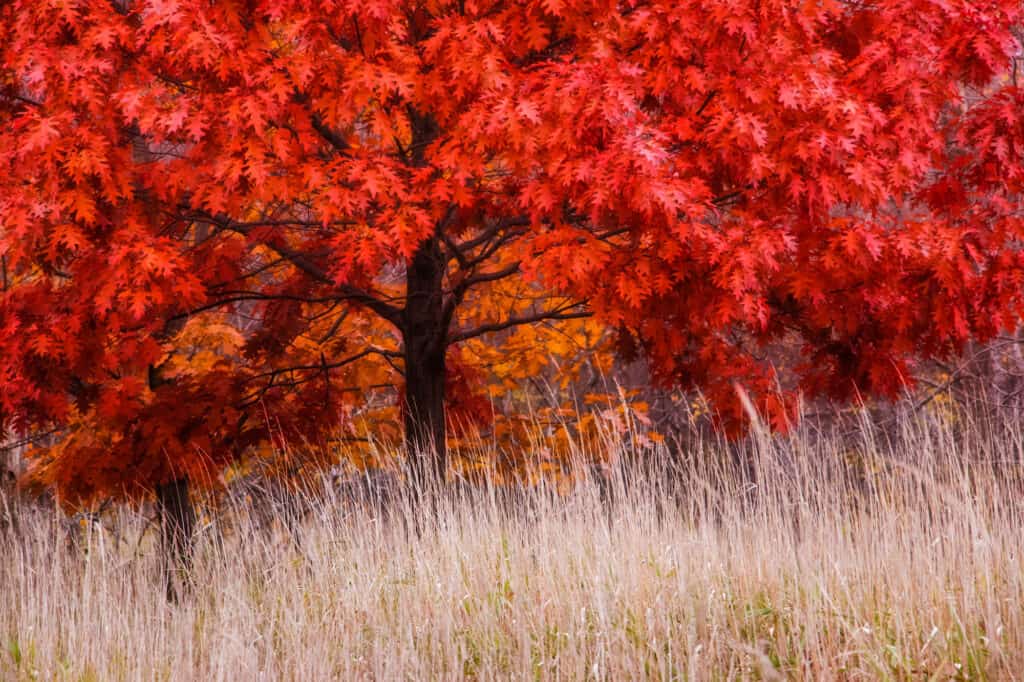
Due to its rounded shape and dense crown, the northern red oak is used for shade and thus planted widely in parks.
©iStock.com/Jean Landry
The tree grows to 92 feet with a trunk of approximately 20 to 39 feet. In normal conditions, the tree takes about ten years to reach a height of five to six meters and has a longevity of up to 400 years. In support of this claim, a northern red oak (commonly known as the Ashford Oak) with a longevity of around 342 years was discovered in 2020 on Giants Oak Lane in Ashford. Windham County.
The tree requires full sun (at least six hours) every day. Its soil preference is acidic, moist sandy, loamy, well-drained, and clay soils. However, it is a drought-tolerant tree.
The tree’s leaves turn russet red to red to bright red in fall. In addition, the tree produces pale yellow-green catkins that expand between April and May.
Due to its rounded shape and dense crown, it is used for shade and thus planted widely in parks. The tree’s acorns are food for small rodents, squirrels, whitetail deer, raccoons, and black bears. Moreover, deer and other herbivores also browse the leaves.
Conclusion
As of 2020, Connecticut’s forest cover was 61%, making it the 14th most forested state in the United States. Therefore, Connecticut is home to many plants that provide food and shelter for birds and animals while increasing the beauty of parks and streets.
Taking care of these plants is vital to increase their longevity and enjoy their ecological importance. Additionally, most trees live longer than 400 years and carry deep histories. You can also buy several flowers, such as the blue-stemmed goldenrod, witch-hazel, and the eastern purple coneflower, to have diverse colors in your home’s landscape or around your garden.
Up Next…
- Animals in Connecticut
- Connecticut’s 7 Best Birdwatching Spots This Summer
- 8 Native Plants in Virginia
- 9 Native Plants in California
The photo featured at the top of this post is © Mircea Costina/Shutterstock.com
Sources
- NPS, Available here: https://www.nps.gov/shen/learn/nature/eastern_hemlock.htm
- Glen Arboretum, Available here: https://wp.towson.edu/glenarboretum/home/american-sycamore/
- Monumental Trees, Available here: https://www.monumentaltrees.com/en/usa/connecticut/windhamcounty/26232_giantoakslane/
- Courant, Available here: https://www.courant.com/news/connecticut/hc-news-ct-forest-report-20201201-xrow7csyzjff7hhe4mwzm7mr2y-story.html
Thank you for reading! Have some feedback for us? Contact the AZ Animals editorial team.






